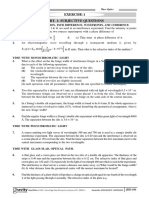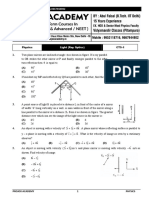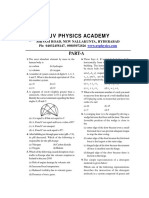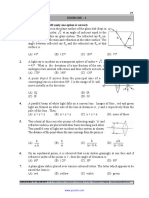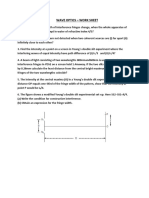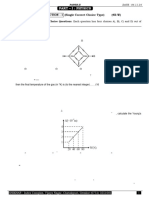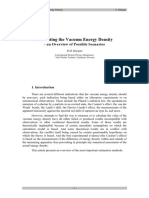Wave Optics Objective Questions
Uploaded by
Dave SmithWave Optics Objective Questions
Uploaded by
Dave SmithWave Optics
1. The fringe width obtained in an YDSE experiment is . If the distance between slits is halved and slit to
screen distance is doubled, the new fringe width becomes:
(a) /4
(b) 2
(c) 4
(d) none
2. Two interfering beams have intensities in the ratio 9:4. The ratio of minimum to maximum intensity is:
(a) 5:1
(b) 1:5
(c) 13:5
(d) 5:13
3. Two interfering beams have amplitudes in the ratio 5:1. The ratio of maximum to minimum intensity is:
(a) 25:1
(b) 1:25
(c) 3:2
(d) 2:3
4. Two beams from two identical slits interfere and form a central maxima of intensity I. when one of the
slits is closed, the intensity at the same location becomes:
(a) I
(b) I/2
(c) I/4
(d) I/
5. In an YDSE 60 fringes are obtained in the field of view when light of wavelength 4000 A 0 is used. How
many fringes will be seen if the wavelength is changed to 6000 A0?
(a) 40
(b) 90
(c) 60
(d) 50
6. Two slits are separated by 1 mm and are illuminated by light of wavelength 6500 A 0. If the screen
distance is 1 m, the distance between the third dark and fifth bright fringe would be:
(a) 0.65 mm
(b) 1.63 mm
(c) 3.25 mm
(d) 4.88 mm
7. The fringe width obtained in an YDSE is 1.33 mm. if the whole set up is immersed in water, the new
fringe width will be:
(a) 1.33 mm
(b) 1.33*1.33 mm
(c) 1.33/2 mm
(d) none
0
8. In a double slit experiment with light of wavelength 5000 A , when a slit of thickness 2.5*10-3 cm is
placed before one slit, the central maxima shifts to the location of the 20 th maxima. The value of is:
(a) 1.25
(b) 1.35
(c) 1.4
(d) 1.5
0
9. Light of wavelength 6328 A is incident on a single slit of width 0.2 mm. If the screen distance is 0.9 m,
the angular width of the central maxima is:
(a) 0.090
(b) 0.720
(c) 0.180
(d) 0.360
10. A slit is illuminated by light of wavelength 6500 A0. The first minimum is obtained at 300. The width of
the slit is:
(a) 3200 A0
(b) 1.24 microns
(c) 6.5*10-4 mm
(d) 2.6*10-4 cm
11. A beam of light consisting of two wavelengths 6500 A and 5200 A is used in YDSE. What is the least
distance from the central maxima where bright fringes due to both wavelengths coincide? Given that
distance between slits is 2 mm and screen is 1.2 m away.
(a) 1.17 mm
(b) 1.56 mm
(c) 1.65 mm
(d) none
12. In YDSE, the distance between slits is 1 mm and the screen is 1 m away. What should be the width of
a single slit to obtain 20 maxima of the double slit set up within the central maxima of the single slit
pattern?
(a) 0.1 mm
(b) 1 mm
(c) 0.01 mm
(d) none
You might also like
- Interference Diffraction Polarization Fibre OpticsNo ratings yetInterference Diffraction Polarization Fibre Optics8 pages
- GR-XII Neet WORKSHEET - PHYSICS (Wave Optics)No ratings yetGR-XII Neet WORKSHEET - PHYSICS (Wave Optics)3 pages
- Archive For NSEP - Qs - 231119 - 104509No ratings yetArchive For NSEP - Qs - 231119 - 10450970 pages
- Resolving Power of Telescope by MR - Charis50% (4)Resolving Power of Telescope by MR - Charis3 pages
- Multiple Choice Linear Electronics Circuits - 102409023651 - 150% (2)Multiple Choice Linear Electronics Circuits - 102409023651 - 115 pages
- Wave Optics: Exercise - I Exercise - Ii Exercise - Iii Answer KeyNo ratings yetWave Optics: Exercise - I Exercise - Ii Exercise - Iii Answer Key12 pages
- Phy - Dpp-Ray Optics and Optical Instruments100% (1)Phy - Dpp-Ray Optics and Optical Instruments10 pages
- Problems On Ray Optics and Optical Instruments For NEET100% (1)Problems On Ray Optics and Optical Instruments For NEET19 pages
- Interefenrece in Thin Films Session 4 (Newton's Rings)No ratings yetInterefenrece in Thin Films Session 4 (Newton's Rings)12 pages
- Indian Association of Physics Teachers: National Graduate Physics Examination 2020100% (1)Indian Association of Physics Teachers: National Graduate Physics Examination 20208 pages
- CLS Aipmt 15 16 XIII Phy Study Package 1 Set 1 Chapter 283% (6)CLS Aipmt 15 16 XIII Phy Study Package 1 Set 1 Chapter 228 pages
- SR - Iit - Incomming-Cosaprk&Spark, Ic Ncert - Jee Main Model: Physics MAX - MARKS: 100No ratings yetSR - Iit - Incomming-Cosaprk&Spark, Ic Ncert - Jee Main Model: Physics MAX - MARKS: 1008 pages
- 01-11-2020 - SR - Super60 - Jee-Adv (2018-P1) - PTA-03 - Question Paper PDFNo ratings yet01-11-2020 - SR - Super60 - Jee-Adv (2018-P1) - PTA-03 - Question Paper PDF24 pages
- Doubtnut Today: JEE Mains Super 40 Revision Series Quadratic EquationsNo ratings yetDoubtnut Today: JEE Mains Super 40 Revision Series Quadratic Equations10 pages
- Ec 2253 Electromagnetic Fields L T P C 3 1 0 4No ratings yetEc 2253 Electromagnetic Fields L T P C 3 1 0 42 pages
- Learning Activity Sheet in Science: Quarter 3 - LAS 4 Waves As A Carrier of EnergyNo ratings yetLearning Activity Sheet in Science: Quarter 3 - LAS 4 Waves As A Carrier of Energy8 pages
- Karlheinz Stockhausen's New Morphology of Musical TimeNo ratings yetKarlheinz Stockhausen's New Morphology of Musical Time70 pages
- Download full Introduction to Sonar Transducer Design John C Cochran ebook all chapters100% (11)Download full Introduction to Sonar Transducer Design John C Cochran ebook all chapters66 pages
- Extra Questions - Forces and Motion MS (COM)No ratings yetExtra Questions - Forces and Motion MS (COM)21 pages
- Download Complete Diffractional Optics of Millimetre Waves 1st Edition I.V. Minin (Author) PDF for All Chapters100% (7)Download Complete Diffractional Optics of Millimetre Waves 1st Edition I.V. Minin (Author) PDF for All Chapters81 pages
- 4 Seismic Behavior of Underground Structures and Site ResponseNo ratings yet4 Seismic Behavior of Underground Structures and Site Response7 pages
- Tests and Acceptance Criteria For Concrete Based On Compressive Strength by Diwan Singh Bora IDSE100% (1)Tests and Acceptance Criteria For Concrete Based On Compressive Strength by Diwan Singh Bora IDSE9 pages
- Estimating The Vacuum Energy Density: - An Overview of Possible ScenariosNo ratings yetEstimating The Vacuum Energy Density: - An Overview of Possible Scenarios25 pages
- 571470-29 Linear Encoders For Numerically Controlled Machine ToolsNo ratings yet571470-29 Linear Encoders For Numerically Controlled Machine Tools60 pages
- Caribbean Examinations Council: CXC SyllabusNo ratings yetCaribbean Examinations Council: CXC Syllabus2 pages
- Acoustics: Architectural Building ServicesNo ratings yetAcoustics: Architectural Building Services20 pages
- School of Oriental and African Studies, Cambridge University Press Bulletin of The School of Oriental and African Studies, University of LondonNo ratings yetSchool of Oriental and African Studies, Cambridge University Press Bulletin of The School of Oriental and African Studies, University of London25 pages
- Physics Paper 1: SECTION B: Question-Answer Book BNo ratings yetPhysics Paper 1: SECTION B: Question-Answer Book B20 pages



